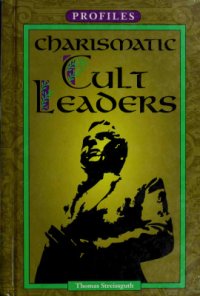
Ebook: Charismatic cult leaders
Author: Streissguth Thomas.
- Genre: Religion
- Tags: Религиоведение, Сектоведение
- Language: English
- pdf
NY.: Oliver Pr In., 1995. - 166 p.
Grade 6-10-A straightfoward look at eight religious cults and their leaders, from the Anabaptists in the Netherlands and John of Leiden to the Branch Davidians and David Koresh. Also included are Mormon founder Joseph Smith; Father Divine; Scientology guru L. Ron Hubbard; Sun Myung Moon and his Unification Church; Jim Jones of the Peoples Temple; and Hare Krishna leader, Prabhupada. Stressing the wildly fluctuating successes and failures that each visionary experienced, Streissguth's narrative emphasizes the events that led to the formation of the cults. He effectively summarizes the basic beliefs of each figure, but he shows little understanding of their charisma and of the spark that lit the fire in the people who joined their unorthodox groups. In addition, he provides very little analysis of each man's impact on cult members and on society at large. Some of the chapters end inconclusively or ambiguously: one criticizes the U.S. government for overreacting to the Branch Davidians, and another claims that for many followers of Scientology, the group's work is "...well worth the cost" of expensive tapes, books, courses, and workshops. Fair-quality, black-and-white photographs are scattered throughout. Daniel Cohen's Cults (Millbrook, 1994) is more analytical and thought-provoking than Streissguth's informative but blandly written book.
Jack Forman, Mesa College Library, San Dieg
Grade 6-10-A straightfoward look at eight religious cults and their leaders, from the Anabaptists in the Netherlands and John of Leiden to the Branch Davidians and David Koresh. Also included are Mormon founder Joseph Smith; Father Divine; Scientology guru L. Ron Hubbard; Sun Myung Moon and his Unification Church; Jim Jones of the Peoples Temple; and Hare Krishna leader, Prabhupada. Stressing the wildly fluctuating successes and failures that each visionary experienced, Streissguth's narrative emphasizes the events that led to the formation of the cults. He effectively summarizes the basic beliefs of each figure, but he shows little understanding of their charisma and of the spark that lit the fire in the people who joined their unorthodox groups. In addition, he provides very little analysis of each man's impact on cult members and on society at large. Some of the chapters end inconclusively or ambiguously: one criticizes the U.S. government for overreacting to the Branch Davidians, and another claims that for many followers of Scientology, the group's work is "...well worth the cost" of expensive tapes, books, courses, and workshops. Fair-quality, black-and-white photographs are scattered throughout. Daniel Cohen's Cults (Millbrook, 1994) is more analytical and thought-provoking than Streissguth's informative but blandly written book.
Jack Forman, Mesa College Library, San Dieg
Grade 6-10-A straightfoward look at eight religious cults and their leaders, from the Anabaptists in the Netherlands and John of Leiden to the Branch Davidians and David Koresh. Also included are Mormon founder Joseph Smith; Father Divine; Scientology guru L. Ron Hubbard; Sun Myung Moon and his Unification Church; Jim Jones of the Peoples Temple; and Hare Krishna leader, Prabhupada. Stressing the wildly fluctuating successes and failures that each visionary experienced, Streissguth's narrative emphasizes the events that led to the formation of the cults. He effectively summarizes the basic beliefs of each figure, but he shows little understanding of their charisma and of the spark that lit the fire in the people who joined their unorthodox groups. In addition, he provides very little analysis of each man's impact on cult members and on society at large. Some of the chapters end inconclusively or ambiguously: one criticizes the U.S. government for overreacting to the Branch Davidians, and another claims that for many followers of Scientology, the group's work is "...well worth the cost" of expensive tapes, books, courses, and workshops. Fair-quality, black-and-white photographs are scattered throughout. Daniel Cohen's Cults (Millbrook, 1994) is more analytical and thought-provoking than Streissguth's informative but blandly written book.
Jack Forman, Mesa College Library, San Dieg
Grade 6-10-A straightfoward look at eight religious cults and their leaders, from the Anabaptists in the Netherlands and John of Leiden to the Branch Davidians and David Koresh. Also included are Mormon founder Joseph Smith; Father Divine; Scientology guru L. Ron Hubbard; Sun Myung Moon and his Unification Church; Jim Jones of the Peoples Temple; and Hare Krishna leader, Prabhupada. Stressing the wildly fluctuating successes and failures that each visionary experienced, Streissguth's narrative emphasizes the events that led to the formation of the cults. He effectively summarizes the basic beliefs of each figure, but he shows little understanding of their charisma and of the spark that lit the fire in the people who joined their unorthodox groups. In addition, he provides very little analysis of each man's impact on cult members and on society at large. Some of the chapters end inconclusively or ambiguously: one criticizes the U.S. government for overreacting to the Branch Davidians, and another claims that for many followers of Scientology, the group's work is "...well worth the cost" of expensive tapes, books, courses, and workshops. Fair-quality, black-and-white photographs are scattered throughout. Daniel Cohen's Cults (Millbrook, 1994) is more analytical and thought-provoking than Streissguth's informative but blandly written book.
Jack Forman, Mesa College Library, San Dieg
Download the book Charismatic cult leaders for free or read online
Continue reading on any device:

Last viewed books
Related books
{related-news}
Comments (0)